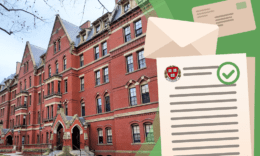Located in the heart of California’s Silicon Valley, Stanford is sometimes called the “billionaire factory,” with alumni including 30 living billionaires and 74 total. Famous Stanford alumni include the founders of Google, Sergey Brin and Larry Page; Sally Ride, the first woman in space; four Supreme Court Justices, and 36 Nobel Laureates.

Stanford is one of the most challenging Universities to gain acceptance to. This post will break down Stanford’s application requirements so you can optimize your application for Stanford.
Stanford University Statistics
Rankings & Enrollment
Around 4% of applicants gained admittance to Stanford in the 2021-2022 academic year. Stanford University is ranked #3 among U.S. universities according to the U.S. News and World Report. 7,645 undergraduate students are currently enrolled in Stanford, along with 10,035 graduate students.
SAT and ACT
Stanford University is currently test-optional, and there is no minimum SAT or ACT score required to get into Stanford. That said, of admitted students who submitted scores in the 2021-2022 admissions cycle, the middle 50% of admitted applicants have SAT Math scores in the range of 740-800, SAT Evidenced-based Reading and Writing in the range of 735-770, and/or Composite ACT scores in the range of 32-35.
GPA
Successful applicants to Stanford have an unweighted average GPA of 3.96. That means that successful applicants maintained near-perfect grades in high school.
Tuition and Financial Aid
Attending Stanford costs $78,898 per year, but due to Stanford’s financial aid policy, the average student attending Stanford pays $17,898. However, Stanford is only need-blind for domestic applicants, which includes U.S. citizens, legal permanent residents, and an undocumented students. If you are an international student, gain admittance to Stanford, and requested financial aid in your application, then Stanford promises to meet 100% of your demonstrated financial need. Otherwise, international students who do not initially request financial aid are not eligible for financial aid at any point in their Stanford career unless their citizenship changes from international to domestic.

What Is Stanford University Looking For?
The High School Experience: Expectations
Stanford University requires that all applicants have a high school diploma or the equivalent in order to enroll.
Stanford takes a holistic admissions approach. This approach takes into account the full picture of your high school experience. Stanford expects to see that you have maximized the opportunities available to you, within reason. The four main tenets of the Stanford admissions department are academic excellence, intellectual vitality, extracurricular activities, and context.
Academic Excellence
Academic excellence in a Stanford applicant means a high-achieving high school record. Challenge yourself with courses outside your comfort zone, including taking at least five courses per semester. If your school only permits you to take fewer than five courses, Stanford admissions would not penalize you for this. But, assuming that you can take five or more courses, the expectation is that you do so during all four years of high school.
Stanford considers these five areas of study to be the five core liberal arts and sciences:
- English—emphasizing writing and literature.
- Math—including algebra, geometry, trigonometry, and ideally calculus and/or statistics.
- History/Social studies—involving essay-writing.
- Science—ideally including biology, chemistry, and physics.
- Foreign language—a non-English language, or a non-native language in the case of students for whom English is a non-native language.
Engaging deeply with and achieving in all five of these areas of study is essential to a Stanford application. Stanford looks for the well-rounded applicant. Maybe you’ve written multiple A+ English essays, participated in the AMC, engaged in your civic community, attended science camp, and joined French Honors Club. Or, if none of these opportunities were available to you, you received uniquely high commendation from all of your teachers in these areas of study.
Stanford expects that you have completed four years of coursework in English and math as well as three or more years in history/social studies, science, and the same foreign language. However, no specific courses are required for any applicants, regardless of major.
Intellectual Vitality
Stanford looks for applicants who will enrich their already vibrant intellectual community. Displaying intellectual curiosity in your essays, extracurricular activities, and the classroom will help you appear authentically engaged to Stanford admissions officers. Taking initiative, exploring your interests, and exhibiting passion toward your areas of interest will all strengthen your Stanford application.
Stanford expects that, if such courses are available, you select Honors, AP, and/or IB courses. It is not necessary for you to take every accelerated or advanced course your school offers. But it is important that you choose the most challenging courses in your professed area of interest, as well as at least one course in a different area of study. For instance, if you apply as a biology major, you should take the AP Biology course your school offers, and the AP US History course that excites you. Even if you’ve taken ten AP courses, if you don’t take AP Biology, Stanford may not see your dedication to the subject matter.
If you have scores from your AP, IB, or GCSE exams/courses, you should submit these scores. As for AP scores, you are not required to submit them, but it’s recommended, unless you score below a 3. If you are enrolled in an IB system or the British education system, you are required to submit your (predicted, if applicable) results. This includes, in the case of British applicants, predicted or actual A-level marks for at least three full A-level courses.
Extracurricular Activities
A great way to clarify your intellectual vitality is through your extracurricular activities. Explore your interests outside of the classroom. Also, don’t be afraid to explore areas you might not be as interested in, or topics outside of your comfort zone. If you want to major in English, then working hard at your school literary magazine will show your dedication and growing experience.
If you can, aim to participate in multiple, varied extracurriculars, or to participate in only one or two but with a great depth of engagement. Admissions officers would like to see you trying new things and displaying curiosity. Still, surface-level engagement with seven different clubs is not as impressive as full and authentic commitment to one extracurricular which means a great deal to you.
Don’t be afraid to take initiative. If you take on too many activities, you can always let some go. Similarly, if you find yourself wanting to pursue an extracurricular which doesn’t appear to exist yet in your community, and it’s possible for you to start it, then do so. Maybe you think your school should have a photography club, or your town needs a group to pick up the trash. Whatever drives you, lean into it and pursue it as far as you can.
Context
Extracurriculars don’t have to pertain to academics. They can be athletic pursuits, religious commitments, gainful employment, or even familial obligations. Stanford’s holistic admissions approach will take into account all of these varied kinds of extracurriculars, as well as what kinds of opportunities were available to you.
Context matters to your Stanford application. Be sure to explain somewhere in your application if you devote a significant portion of your time to childcare, elder care, household management, or other personal matters that may have prevented you from engaging in other extracurriculars. Likewise, if your school offered a wide range of clubs but none possessed enough funding to provide meaningful experiences, then clarify why you were more or less engaged with those opportunities.
Lastly, if there were/are any extenuating circumstances which may have affected your GPA, test scores, high school transcript, or other aspects of your application which will not be clarified in your application by default or by your counselor, be sure to elaborate on these circumstances in the additional information section of the Common App.
Stanford University Application Requirements
The Application
Stanford accepts the Common Application, and only the Common App, unless you qualify for the QuestBridge program, so be sure to complete the appropriate application.
Application Fee
You must submit a $90 non-refundable application fee or fee waiver in order to apply to Stanford.
ACT/SAT Scores
Taking the ACT and/or the SAT is always recommended for students interested in applying to Stanford but not required. You will maximize your chances of acceptance if your scores fall above the 50th percentile of accepted applicants. If your scores fall below the 25th percentile of accepted applicants and you have time before the deadline to retake one or both of these standardized tests, then you should do so, but if not, then you may want to take advantage of Stanford’s current test-optional status.
Official Transcript(s) or Academic Results
Your transcript paints a picture of your high school experience, from the classes you’ve taken to the grades you’ve achieved, and more, depending on what your school offers. Although your school sends in your transcripts and/or academic results to Stanford, not you as the student, if you can, take a look at the documents your guidance counselor is planning to send. Make sure that all of your classes are listed, even electives, with their Honors, AP, IB, or other status noted. If you have received any academic honors from your school, these should also be included.
School Report Form and Counselor Letter of Recommendation
Your school will handle these application items, but you can still take responsibility for them. Always confirm that these materials have been submitted on your behalf. In addition, you can build a relationship with your counselor in order to better facilitate their writing of your recommendation letter. Your counselor may have many students to worry about and write letters for, so if you can differentiate yourself and give your counselor a chance to understand you as a person, the letter will benefit. Even if your counselor already has a high opinion of you, if they know you personally, their letter will be much more authentic, specific, and memorable to the college admissions officers.
Letters of Recommendation From Two Teachers
Like your counselor, your two teacher recommendations provide an opportunity for college admissions officers to see another side of who you are from the perspective of an adult who, ideally, knows you well.
Your teachers may receive many requests for letters of recommendation, so it’s important for you to establish relationships with your teachers throughout the school year and request these letters early, at least one month before the deadline. You may still get a letter if you request one last minute, but it will necessarily be more rushed and less thoughtful. Regardless, speak to your counselor early on to make sure you know your school’s specific guidelines for requesting recommendation letters from teachers.
If you have another person in your life who knows you well and can provide insight into who you are that the teacher and counselor recommendations cannot, then you may submit a third letter of recommendation. This letter is submitted under “Other Recommender” and does not necessarily have to be written by a teacher.
Midyear Transcript (by February 15)
This is another material your school will handle. Be sure to keep your first and second semester grades on par with or better than your grades in the first three years of high school. Even if your grades were not perfect when you were an underclassman, showing consistent effort and ideally improvement will put you in a better position for success.
Essays
In addition to the writing required by the Common App, Stanford asks all applicants to submit supplemental essays specific to the Stanford application. For a more detailed breakdown of how to write the Stanford Supplemental Essays, see this post.
Interview
Stanford University considers interviews an optional application supplement. Interviews are conducted locally with Stanford alumni. Therefore, if there are no available and willing Stanford alumni in your local area, you may not be offered an interview. If you are offered an interview, you are not required to proceed with it.
Regardless, it is recommended to participate in an interview if you are offered one. The interview is less of an opportunity for Stanford to learn more about you and more for you to learn more about Stanford. Although it is important for you to be polite and speak positively, but not arrogantly, about yourself in the interview, it is even more important that you come prepared to ask the interviewer 3-5 questions. These questions should be specific to Stanford and their answers should not be available to you on the internet already.
Arts Portfolio
Stanford admissions officers value artistic talent, creation, and engagement highly. Although the arts portfolio is optional, applicants who are high-achieving artists are encouraged to share a portfolio of their best work in one of the following areas:
- Art Practice
- Dance
- Music
- Theater and Performance Studies
To learn more about the specific requirements for each artistic areas’ portfolio, see the arts portfolio page on the Stanford admissions website linked here.
Deadlines
Stanford offers both Restrictive Early Action and Regular Decision application timelines.
The deadline to submit a restrictive early action application with an arts portfolio is October 15. The material for the arts portfolio is October 20. The deadline to submit a restrictive early action application without an arts portfolio is November 1. Decisions for restrictive early action were released in mid-December, and accepted students must reply with their decision to enroll or not enroll by May 1.
The deadline to submit a regular decision application with an arts portfolio is December 5. The material for the arts portfolio is due December 10. The deadline to submit a regular decision application without an arts portfolio is January 5. Decisions for regular decision will be released in early April, and accepted students must reply with their decision to enroll or not enroll by May 1.
Although Stanford is one of the toughest schools to gain admittance to, it is also one of the most esteemed institutions of higher education in the world. Even if you are not among the lucky 4% in this admissions cycle, bear in mind that just by applying to Stanford you have exhibited ambition, effort, and bravery. Try your best, and best of luck.





